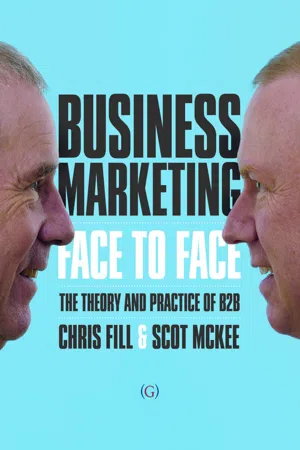Marketing
Market Segmentation Targeting and Positioning
Market segmentation involves dividing a market into distinct groups of buyers with similar needs and characteristics. Targeting is the process of selecting the most attractive segments to focus on based on the company's resources and objectives. Positioning involves creating a distinct image and identity for a product or brand in the minds of the target market.
Written by Perlego with AI-assistance
Related key terms
1 of 5
12 Key excerpts on "Market Segmentation Targeting and Positioning"
- eBook - ePub
- Paul Reynolds, Geoff Lancaster(Authors)
- 2005(Publication Date)
- Routledge(Publisher)
Segmentation, Targeting and Positioning
DOI: 10.4324/9780080455020-55.1 Introduction
Market segmentation and targeting can be defined as:The process of breaking down the total market for a product or service into distinct sub-groups or segments, where each segment may conceivably represent a distinct target market to be targeted with a distinctive marketing mix.To improve opportunities for success in a competitive market environment, marketers must focus their effort on clearly defined market targets. The intention is to select those groups of customers that the company is best able to serve in such a way that it does this in a superior manner to competitors. The sequential steps in this process are segmentation, targeting and positioning. We now examine each of these steps.There are increasingly more segmentation bases available, which means that targeting and positioning strategies are becoming more meaningful.5.2 The Need for Segmentation
The essence of the marketing concept is to place customer needs at the centre of the organisation’s decision making. In addition, the need to adopt this approach is a result of increased competition, more informed and educated consumers and changing patterns of demand. It is this latter point that has given rise to the need to segment markets.People do not purchase exactly the same kinds of products as each other. They may have different tastes in clothes or in the type of holidays they take. Perhaps they purchase different brands of toothpaste or breakfast cereals. This obvious example shows that market segmentation and the subsequent strategies of targeting and positioning start by recognising that increasingly, within the total demand/market for a product, specific tastes, needs and amounts demanded may differ.We refer to a market that is characterised by differing individual preferences as being ‘heterogeneous’. Market segmentation breaks down a total differently behaving market for a product or service into distinct sub-sets or segments, with customers who share similar demand preferences being grouped together with each segment. This is illustrated in Figure 5.1 - Available until 4 Dec |Learn more
Strategic Marketing
An Introduction
- Tony Proctor(Author)
- 2002(Publication Date)
- Routledge(Publisher)
tenSEGMENTATION,
TARGETING AND
POSITIONING
INTRODUCTIONThe market that the organization sees through the strategic window is a very complex entity. In evolving strategies to take advantage of the opportunities that exist within it, the organization has to divide it into manageable chunks at which it can direct its relevant resources and capabilities.Segmentation, targeting and positioning are three of the pillars of modern marketing strategy. There are few markets these days in which an undifferentiated approach will pay dividends. The approach today is to accept that there are different demands in the market place and that a product or ser vice needs to be tailored-in specifically to meet these differing demands if it is to stand the best chance of success. The first step in the process of achieving this is to research the market to identify how it might best be segmented into buying groups that are significantly different from one another in ter ms of their buying behaviour and product or ser vice requirements. Having identified this and analysed the market along appropriate lines so that there are segments to the market, the next step is to decide which are financially viable propositions as far as the organization is concerned. Some may be too small or others too competitive. It is the task of targeting to define for the organization those that promise the kind of retur ns on investment that will help the organization achieve its objectives. Lastly there is the question of how to place or position oneself in the minds of the users in the targeted segments so that the product or service the organization has to offer stands out from those of competitors. Competitive positioning is the last of the three steps.SEGMENTATION
Products can be designed and marketed so as to have a more or less general appeal to most members of a market. However, customers have varying wants and needs and firms are likely to achieve a greater competitive advantage by producing a number of different offerings to meet the needs of specific segments. Attention is given to procedures for identifying market segments, choosing the best market segments in which to operate and deciding the strategy to effect in entering market segments. - eBook - PDF
Culture and Positioning as Determinants of Strategy
Personality and the Business Organization
- Tony Ellson(Author)
- 2004(Publication Date)
- Palgrave Macmillan(Publisher)
Part II Literature Review 21 2 Segmentation, Targeting and Positioning ‘Marketing as strategy is the emphasis at the SBU level on market segmentation, targeting, and positioning in defining how the firm is to compete in its chosen businesses.’ (Webster, 1992: 10) The three major steps of segmentation, targeting and positioning are widely considered to be central to the decision and planning process of marketing with the purpose of identifying and selecting potential buyers and communicating distinctive product benefits in the market. This chap- ter considers literature relating to segmentation, targeting and positioning, and finally, the strategic role of positioning in segmentation and targeting. Segmentation Wendell Smith (1956: 5) first articulated the need for a ‘more precise adjustment of product and marketing effort to consumer or user require- ments’ based on the recognition that different products are generally purchased by different groups of people. Segmentation attempts to identify homogeneous demand function within a heterogeneous market demand function and Dhalla and Mahatoo (1976: 41) point to the advantage of ‘how these differences can be exploited to increase the productivity of the firm’s marketing program’. Segmentation is the process of partitioning a market into groups of potential customers who are similar in designated ways and who are likely to exhibit similar purchase behaviour (Weinstein, 1987). Market segmentation is a means of identifying and resolving four characteristic types of marketing problem; defining the market; ration- alising policies for existing brands and products; positioning ranges of brands and of product varieties; and identifying gaps in the market which 22 Literature Review offer new market opportunities (Tynan and Drayton, 1987). The goal of ‘getting close to the customer’ is meaningless because a marketer cannot effectively satisfy a wide range of customers equally (Shapiro, 1988: 120). - eBook - PDF
Strategic Marketing Management in Asia
Case Studies and Lessons across Industries
- Syed Saad Andaleeb, Khalid Hasan(Authors)
- 2016(Publication Date)
- Emerald Group Publishing Limited(Publisher)
6 ▾ Market Segmentation, Targeting, and Positioning Syed Saad Andaleeb This chapter provides the students with a basic understanding of Segmentation, Targeting, and Positioning. Students will be able to understand the need for seg-mentation and how to position a product in selected target markets. In addition to explaining concepts, the chapter refers to a real life segmentation situation through analyzing a case. Many marketers in the developing countries practice mass market-ing . With a vague sense of their customer group(s) or markets, their idea is to offer products mainly in the large population cen-ters, hoping that this approach will result in volume sales. The strategy is often directed at the largest set of customers (e.g., in a major city, at bus or train terminals, on busy streets, places of reli-gious gatherings, large village markets, etc.) by offering a standar-dized, low-cost item which will supposedly sell because of the product ’ s functionality and low price. Such a strategy ignores dee-per customer characteristics, varying tastes, or their desire to stand out and be distinct. By customizing products closely to fit distinct 179 demographic, psychographic, geographic or some other character-istic, or by focusing on specific customer needs or wants, and con-sidering how they are likely to respond behaviorally to a particular offering, a product ’ s appeal and desirability can be sig-nificantly enhanced. Such customization represents a focus on segmented markets consisting of a set of customers who share a similar set of needs and wants and behave similarly to marketing appeals and offer-ings. This set of customers is called a market segment. The act of market segmentation, therefore, represents an effort to identify and categorize groups of customers into clusters that demonstrate some similarity traits. - eBook - PDF
- Harvard Business Review, Alvin J. Silk(Authors)
- 2006(Publication Date)
- Harvard Business Review Press(Publisher)
Part II Developing Marketing Strategies 3. Market Segmentation, Target Market Selection, and Positioning A FTER THE MARKETING ANALYSIS PHASE, THE NEXT stage in the marketing process consists of the follow-ing three steps: 1. Market segmentation 2. Target market selection 3. Product positioning These steps are the prerequisites for designing a successful mar-keting strategy. They allow the firm to focus its efforts on the right 85 This chapter was written by Miklos Sarvary and Anita Elberse and origi-nally published as “Market Segmentation, Target Market Selection, and Positioning,” Class Note 9-506-019 (Boston: Harvard Business School Publishing, 2005), a revised version of a note by M. Sarvary. It was lightly edited for consistency. customers and also provide the organizing force for the marketing mix elements. Product positioning, in particular, provides the syn-ergy among the four P s (product, price, place, and promotion) of the marketing plan. 1 This chapter elaborates on each of the three steps. Market Segmentation Market segmentation consists of dividing the market into groups of (potential) customers—called “market segments”—with distinct characteristics, behaviors, or needs. The aim is to cluster customers in groups that clearly differ from each other but show a great deal of homogeneity within the group. As such, compared with a large, heterogeneous market, those segments can be served more effi-ciently and effectively with products that match their needs. It is important that the segments are sufficiently different from each other. In addition, it is critical that the segmentation is based on one or more customer characteristics that are relevant to the firm’s marketing effort. A thorough analysis of the customers is essential in that regard. There are two (related) types of segmentation: 1. Segmentation based on benefits sought by customers 2. - eBook - PDF
Principles of Marketing
A Value-Based Approach
- Ayantunji Gbadamosi, Ian Bathgate, Sonny Nwankwo(Authors)
- 2013(Publication Date)
- Bloomsbury Academic(Publisher)
For example, implementing an undifferentiated approach when your competitors are using a differentiated approach might be disastrous. Also, given the existence of competi-tion, an organization can identify the segments where the competition is strong and then consider whether to compete in the same segment or to find another segment that would be more favourable to it (Brassington and Pettitt, 2006). Positioning the product offering Having divided the market into smaller groups and determined the size and potential of each ( segmentation ), and having also chosen particular target markets ( targeting ), the third and last stage of the STP process should then position a product offering in the target market(s). This is known as positioning. Lancaster et al. (2002) define positioning as ‘the act of designing a company’s product and marketing mix to fit a given place in the mind of the consumer’. Positioning deals with all the activities undertaken by an organization to create and maintain in the minds of customers the concept of value about its product compared with competitors’ products. It enables businesses to distinguish their products in the minds of their customers. According to Ries and Trout (2001), positioning is not about what you do to a product, but about what you do to the mind of a prospect. It concerns the perception that a prod-uct produces in the mind of customers when compared with competitors’ products and even with other products from the same organization. Perception varies from person to person. For instance, what you perceive as quite expensive might be easily affordable to someone from a richer background or who earns much more than you do. Also, what you perceive as fashionable will be different from your mother’s perception or that of a friend of yours. However, it is important to note that there might be similarities in perception among different people. Think and discuss Pick a particular market targeting strategy. - eBook - PDF
- Louis Boone, , David Kurtz, , Louis Boone, David Kurtz(Authors)
- 2018(Publication Date)
- Cengage Learning EMEA(Publisher)
CHAPTER 9 Market Segmentation, Targeting, and Positioning CHAPTER 10 Marketing Research TARGET MARKET SELECTION 3 Copyright 2019 Cengage Learning. All Rights Reserved. May not be copied, scanned, or duplicated, in whole or in part. Due to electronic rights, some third party content may be suppressed from the eBook and/or eChapter(s). Editorial review has deemed that any suppressed content does not materially affect the overall learning experience. Cengage Learning reserves the right to remove additional content at any time if subsequent rights restrictions require it. 9.1 Describe the two primary market classifications. 9.2 Summarize the three components necessary for effective market segmentation. 9.3 Describe four types of geographic segmentation. 9.4 Summarize the five most commonly used demographic variables. 9.5 Contrast psychographic segmentation with other segmentation variables. 9.6 Describe the three forms of behavioral segmentation. 9.7 Distinguish between the three basic strategies for reaching target markets. 9.8 Explain how marketers build value propositions utilizing positioning strategies. 9.9 Given a target market profile, classify each variable according to its base of segmentation. LEARNING OBJECTIVES MARKET SEGMENTATION, TARGETING, AND POSITIONING 9 Source: www.chapel-view.com Copyright 2019 Cengage Learning. All Rights Reserved. May not be copied, scanned, or duplicated, in whole or in part. Due to electronic rights, some third party content may be suppressed from the eBook and/or eChapter(s). Editorial review has deemed that any suppressed content does not materially affect the overall learning experience. Cengage Learning reserves the right to remove additional content at any time if subsequent rights restrictions require it. OPENING EXAMPLE PepsiCo has a strong lead over Coca-Cola in bottled water, juices, and sports drinks—which are some of the fastest growing beverage categories. - eBook - PDF
- Daniel Padgett, Andrew Loos(Authors)
- 2023(Publication Date)
- Wiley(Publisher)
117 CHAPTER 6 Using Segmentation, Targeting, and Positioning to Distinguish a Brand Within the Market CHAPTER OUTLINE LEARNING OBJECTIVES When you finish this chapter, you should be able to: 6.1 Segmentation Market Segmentation Definition and Purpose Segmentation Variables 6.1 Define market segmentation and describe the four common categories of variables for segmenting a market. 6.2 Applied Segmentation The Segmentation Process Criteria for Effective Market Segmentation 6.2 List and describe the six steps in the market segmentation process and describe the key criteria for effectively segmenting a market. 6.3 Using Segmentation as a Foundation for Marketing Strategy Targeting Positioning 6.3 Define targeting and positioning and describe the purpose and process of each for developing marketing strategy. Introduction “People don’t hate advertising. They hate bad advertising.” When he made this statement, Pat Pellegrini was not just trying for a memorable quote. The point he makes is critical to market- ing success and has been echoed by most every successful marketer over the last 50 years. Peo- ple are busy. They are bombarded with marketing messages each day, and they only want to see and hear what is important to them. Given that there are relatively few truly new products, and given increasing competition, marketers have to differentiate their offerings by accurately understanding and appealing to a more specific group of customers. While most marketers would agree that identifying meaningful groups of customers and differentiating your offering is critical to success, how to do this effectively is not obvious. Pellegrini, however, provides some clues to this process. First, he explained that the key to getting important messages to the right person is actually knowing what the person wants, not just at the surface level, but from a deep understanding of what interests and motivates customers, and what influences their behavior. - eBook - PDF
Applied Marketing
Connecting Classrooms to Careers
- Daniel Padgett, Andrew Loos(Authors)
- 2019(Publication Date)
- Wiley(Publisher)
In it you will learn the basics of segmentation, targeting, and positioning, the foundation for all tactical marketing decisions in the marketing mix. 6.1 Segmentation Companies will not survive if their marketing strategy is dependent upon targeting an entire mass market. The importance of market segmentation is that it allows a business to precisely reach a consumer with specific needs and wants. As a marketing professional segmentation will be crucial to your success. Market Segmentation Definition and Purpose As you learned in the previous chapter, one of the primary purposes for conducting market research is to gain a better understanding of what customers want. Companies want to un- derstand what customers value to create more appealing exchanges. Importantly, different customers value different things, which means marketers need some way to distinguish be- tween customers who want one thing and customers who want something else. This process is called market segmentation. Market segmentation is the process of categorizing groups of customers to divide a market into manageable pieces based on customer differences. Anything that might be a useful differentiating factor could be a possible segmentation factor. For example, some customers use their mobile phones mostly to talk, while others primarily use text messaging. Still others are heavy data users, using their mobile phone for communication but also for a host of other activities that require large amounts of data. A wireless provider might distinguish between these different segments, or groups of customers who share common char- acteristics within a market, based on their primary use of the mobile phone. To meet the needs of these different groups based on how they use their mobile phone differently, the wireless pro- vider might offer different service plans based on type and level of usage. - eBook - PDF
- Chris Fill, Scot McKee(Authors)
- 2011(Publication Date)
- Goodfellow Publishers(Publisher)
(2011). Strategy: Segmentation, Positioning and Pricing 5 145 Summary Here are the key points about segmentation and pricing issues, set out against the learning objectives. 1 Examine the bases for segmenting business markets. Segmentation is a technique for dividing a mass market into identifiable subunits, in order that the individual needs of buyers and potential buyers can be more easily satisfied. Traditionally it is about the division of a mass market into distinct groups that have common characteristics, needs and display similar responses to marketing stimuli. 2 Consider the breakdown and build-up approaches to market segmentation in B2B markets. The breakdown method assumes that a market consists of businesses (and buyers) that are essentially the same, so the task is to identify groups that share particular differences . The breakdown approach is perhaps the most established and well recog-nised. The build-up method considers a market to consist of businesses that are all different, so here the task is to find similarities . The build-up method is customer-orientated as it seeks to determine common customer needs. 3 Explore some of the processes used to select target markets. The goal is to identify segments that in the medium to long term will provide suitable returns. The selection of target segments should be based on a systematic analysis of the market. This involves first considering the market characteristics and then moving through to the buyer characteristics. 4 Evaluate the practice of segmentation in business markets. Segmentation is a theoretically neat concept, but a practically challenging idea to utilise. As a result one of the major problems associated with segmentation in B2B markets is a failure by businesses to implement segmentation plans. There are three main barriers preventing or hindering the way in which organisations practice seg-mentation activities. - eBook - PDF
- Daniel Padgett, Andrew Loos(Authors)
- 2021(Publication Date)
- Wiley(Publisher)
This chapter provides an overview of how to group customers and how to select a meaningful group as a foundation to build marketing strategy. In it, you will learn the basics of segmentation, targeting, and positioning, the foundation for all tactical marketing decisions in the marketing mix. 6.1 Segmentation Companies will not survive if their marketing strategy is dependent upon targeting an entire mass market, because markets have fragmented over time as customers become more knowl- edgeable and more demanding, and competitors offer more options over time as a market develops. The importance of market segmentation is that it allows a business to precisely reach a consumer with specific needs and wants. Successful segmentation will be crucial to your company’s success. Market Segmentation Definition and Purpose As you learned in the previous chapter, one of the primary purposes for conducting market research is to gain a better understanding of what customers want. Companies want to under- stand what customers value to create more appealing exchanges. Importantly, different cus- tomers value different things, which means marketers need some way to distinguish between customers who want one thing and customers who want something else. This process is called market segmentation. Market segmentation is the process of categorizing groups of custom- ers to divide a market into manageable pieces based on customer differences. Anything that might be a useful differentiating factor could be a possible segmentation fac- tor. For example, some customers use their mobile phones mostly to talk, while others primarily use text messaging. Still others are heavy data users, using their mobile phone for communication but also for a host of other activities that require large amounts of data. - Scott McCabe(Author)
- 2010(Publication Date)
- Routledge(Publisher)
The aim of segmentation is clearly to maximise the return on the organisation’s investment in marketing and to ensure that tourism and hospitality services meet selected customers’ needs, values and expectations. But as mentioned previously, the STP process can lead to a fundamental repositioning of the products and services and ultimately organisational strategy in some cases. Significantly, market segmentation works on the basis that only in very exceptional circumstances does marketing communications need to try to reach the whole of the market. Since advertising space is expensive and since there is a proliferation of media forms and channels and a great deal of fragmentation of audiences across these, the financial risks associated with market segmentation strategies are very high.Today’s advanced consumer market economies are characterised by- pervasive mediation within the realms of everyday life
- product placement and sponsorship of television and film programming
- celebrity endorsements
- blurring of distinctions between marketing communications and other information (e.g. advertorials).
- how effective their marketing communications are
- how people respond
- which media channels were most effective
- what is the ROI for marketing spend.
Consumers actively filter out unnecessary information and seem to make rapid judgements as to the relevance of messages to them personally. This makes segmentation important for successful product positioning and to ensure that the desired responses to marketing mix (including communications) strategies are elicited.Segmentation Options
There are a number of different approaches to segmentation. The ones chosen will affect the approach taken to the organisation’s marketing communications strategy as follows:- Single segmentation (concentrated marketing) Here a single basis of segmentation is chosen which allows the organisation to concentrate its marketing, sales and promotion activity in particular, focused ways. One example might be the Saga group of products, including Saga Holidays, which uses a single point of segmentation, the over 50’s age group market, as the focus of the marketing mix and communications strategy. This market segment is growing and the 1950s market for tourism is a mature and high value market. Another smaller and more emerging market segment example might be the single-traveller market. In the UK, specialist tour operators have emerged in the recent years which have recognised the importance of the single-unattached traveller market. Examples include Solo’s Holidays (http://www.solosholidays.co.uk/ ) and Friendship Travel (http://www.friendshiptravel.com/ ). These organisations offer specially designed marketing mixes specifically aimed at the singles market. In the UK, single occupancy households have been the fastest rising form of new living arrangements in the past few years and demand has partially fuelled the housing boom. High divorce rates, career aspirations amongst women and more people opting out of parenthood are some of the reasons for this growth and there are still many barriers for people in a range of different groups to travelling on their own. Mintel produced a report in 2001
Index pages curate the most relevant extracts from our library of academic textbooks. They’ve been created using an in-house natural language model (NLM), each adding context and meaning to key research topics.











